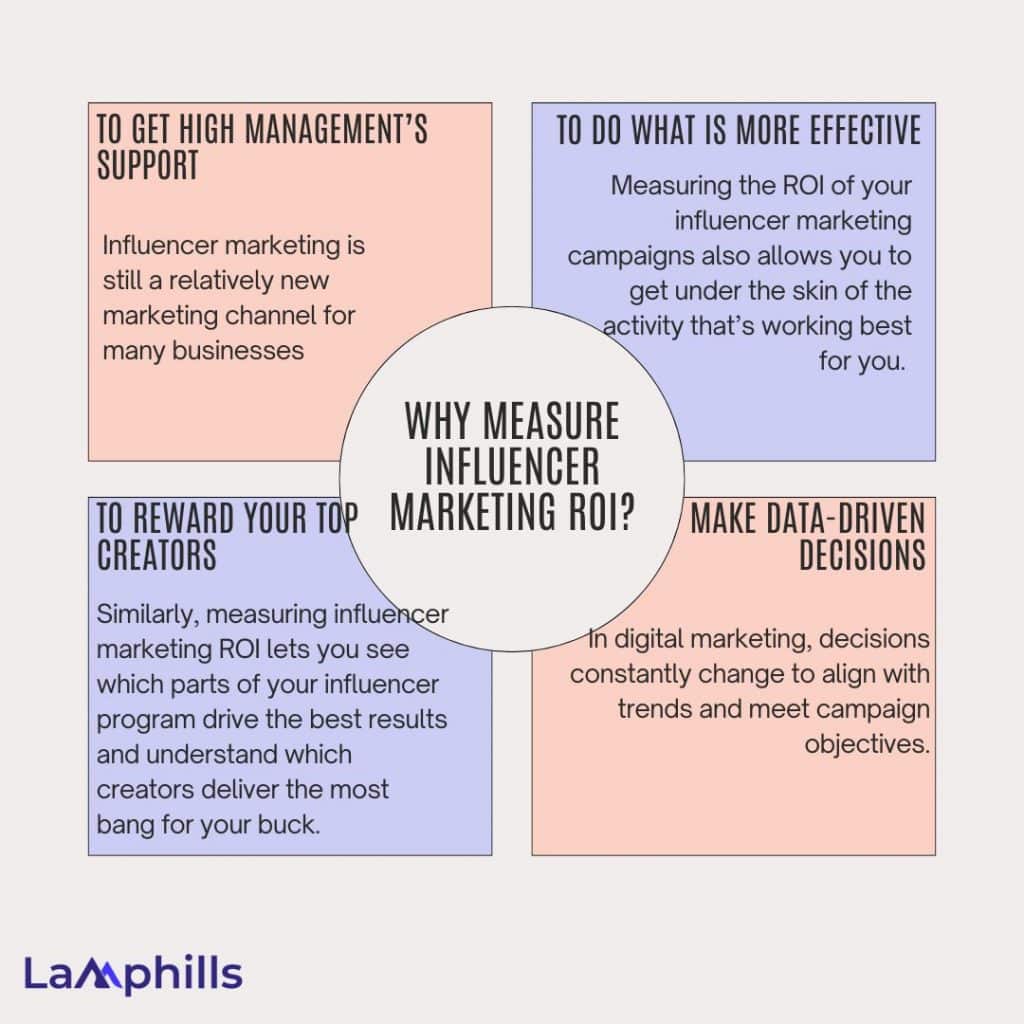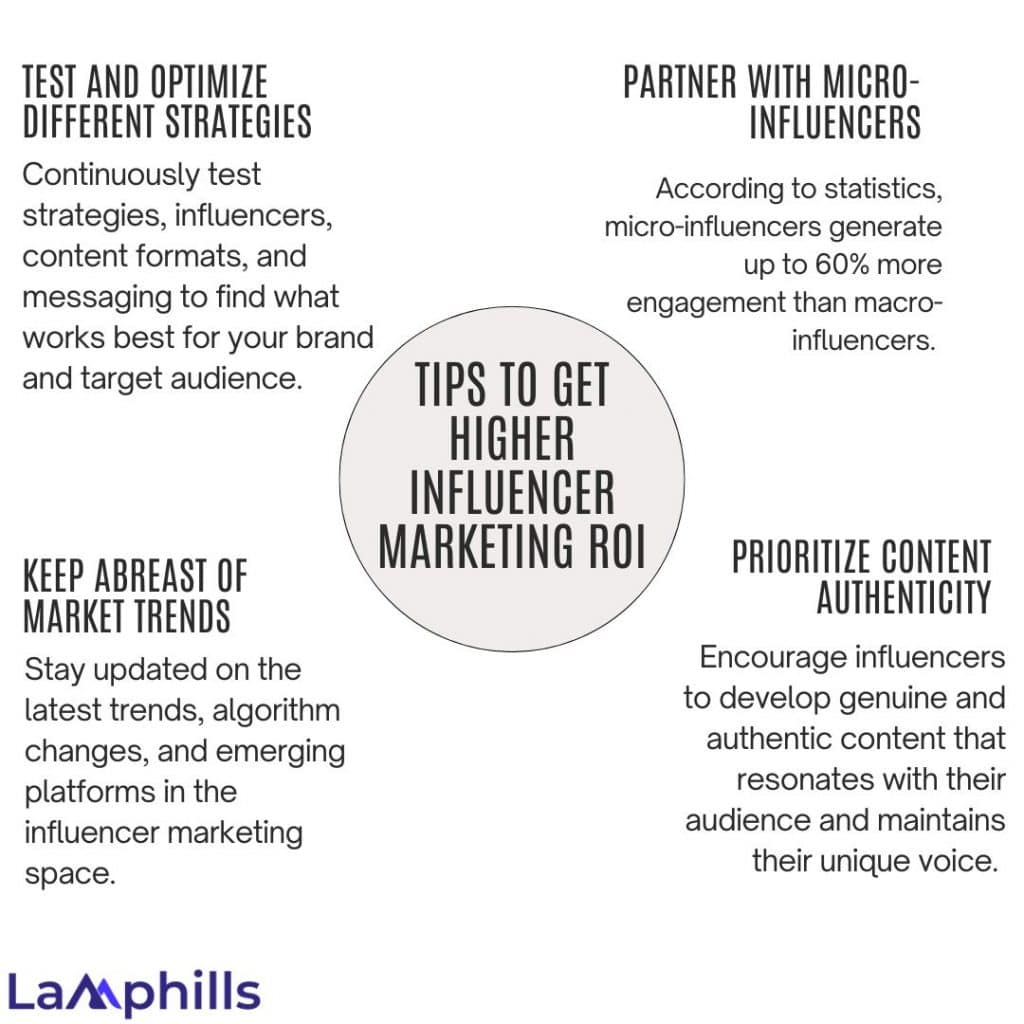If you want to know how to measure your influencer marketing ROI and improve campaign performance, you’re in the right place!. Come along as we explore the best strategies for measuring the ROI of your influencer marketing.
Whether you’re an influencer marketing pro or one of the 30% still not tracking ROI—here’s what you need to know to measure the success of your campaigns.
Key Points
- Influencer marketing ROI measures the profitability and effectiveness of influencer campaigns by comparing the revenue or value generated to the campaign’s cost.
- Brands average $5.78 in revenue for every $1 spent on influencer marketing, with the top 13% achieving $20 or more per $1 spent.
- You should measure your influencer marketing ROI to gain high management support, identify effective strategies, reward top creators, and make data-driven decisions.
- The formula for calculating your influencer marketing ROI is (Revenue / Cost) x 100.
- 86% of marketers believe influencer marketing meets brand objectives, improving customer acquisition and revenue.
What Is Influencer Marketing ROI?
Influencer marketing ROI (Return on Investment) measures the profitability and effectiveness of campaigns involving influencers. It quantifies the return gained from the money invested in hiring influencers to promote products or services. ROI is calculated by comparing the revenue generated or value created by the influencer campaign to its cost.
Once you understand the above definition of influencer marketing ROI, let’s move on to why you need to measure it.
Why Measure Influencer Marketing ROI?

Well, when it comes to influencer marketing specifically, there are a few reasons:
#1. To Get High Management’s Support
Influencer marketing is still a relatively new marketing channel for many businesses. There are advantages and disadvantages to this. On the one hand, there are no preconceived notions, so you can truly make an impression with your early performance. However, there may be some initial skepticism, mainly if your main objectives are engagement and brand awareness, which can be challenging to demonstrate impact in the near term.
This is why it helps to have a clear idea of the metrics you’re using to measure influencer marketing ROI across a range of goals and know how to present these in a way that showcases impact.
#2. To Do What Is More Effective
Measuring the ROI of your influencer marketing campaigns also allows you to understand the activity that’s working best for you. Are you seeing solid results from an affiliate marketing campaign? Or perhaps a new brand ambassador program has prompted a severe uplift in awareness and sales?
This is your opportunity to take advantage of those outcomes and intensify the brand-building action that is working the best. Additionally, you can utilize your campaign wrap deck to present these findings to your executive team and potentially secure additional funding to carry them out.
#3. To Reward Your Top Creators
Similarly, measuring influencer marketing ROI lets you see which parts of your influencer program drive the best results and understand which creators deliver the most bang for your buck. You can reward top-performing influencers, nurture relationships, and explore new ways to turn these creators into long-term brand partnerships.
#4. Make Data-Driven Decisions
In digital marketing, decisions constantly change to align with trends and meet campaign objectives.
Marketers and brand owners often ask questions such as:
- “Should I change my content type from promotional to informational?”
- “Should I implement more promo codes, discount codes, or loyalty reward programs in my influencer marketing strategy?”
- “Should I hire micro-influencers rather than macro-influencers?”
Measuring your business’s KPIs and financial metrics can help you answer these questions.
You can adequately identify which influencer marketing platforms, posts, or content formats deliver the best results and make informed choices based on this information.
Now that you know all these benefits, let’s explore how you can measure the ROI of your influencer marketing efforts.
How to Measure Influencer Marketing ROI: 6 Simple Steps
Influencer marketing doesn’t have to be a black box. There are many ways to measure the ROI of your influencer marketing and activities. Here are the 6 most effective steps.
#1. Affiliate Links

Generating a unique affiliate link for an influencer allows you to track online sales made through their social channels. Influencers typically receive a commission from these sales. These links will also provide data about the number of clicks on your site and the number of sales with the average order size. There is one issue here. The link cookie may be valid for around 30 days at most, so if a customer decides to purchase after that time, you won’t be able to connect this sale with the influencer campaign you run. Another thing is that some customers don’t trust weird-looking affiliate links.
The good news is that purchasing things from the Instagram feed shortens the user experience and boosts impulse purchases. Instagram and other well-known platforms are now offering shopping post alternatives.
#2. UTMs
Urchin Tracking Modules (UTMs) are the most accessible ROI tracker to implement and the most versatile simultaneously. You only need to add a couple of structured parameters to a link. Once a visitor clicks on it and enters your site, your Google Analytics (or any other web traffic analysis tool) will digest them. Every influencer and campaign has different parameters so that Google Analytics can present the traffic source correspondingly.
But UTM has its problems, too – they can be easily removed from the link and make links way longer, which might decrease their credibility in the eyes of potential consumers. To get around these shortcomings, you can use link shorteners. Their sole purpose is to hide the original link with a long UTM part under a shorter one. So, instead of
https://averylonglinktoyourshop.com/product/gallery?utm_source=instagram&utm_medium=influencer_post&utm_campaign=spring_retention
You get
https://goo.gl/k7T5jm.
Additionally, some link shorteners monitor the number of clicks independently so that you can monitor the traffic with an additional channel (for example, Bitly).
Read also: GOOGLE UTM: What Are UTM Codes in Google Analytics & GA4
#3. Dedicated Landing Pages

Link shorteners may be perceived as suspicious at best, and shortened links can lead to distrust and fewer clicks. One solution is to use providers that allow you to use branded links.
The other is to ditch link shortening altogether and replace it with landing pages with unique links. Here’s an example of the structure you can use: https://acme.com/campaign/influencer1. Assigning a unique landing page to each influencer campaign requires introducing a landing page generator. Landing page software providers often offer detailed traffic analytics. They are usually integrated with Google Analytics to put campaign performance results under a unified report.
#4. Brand Engagement
If the campaign is focused on engagement, you can request the influencer to direct the customers to your website. Then, you can easily see the traffic coming from a social media reference or to your channel (in case of placements where a link cannot be used). You can measure your follower/engagement rate change and how it translates to ROI. A good practice is creating a hashtag for the influencer and seeing how popular it gets. This also works well with some contests on your brand’s side.
By knowing the number of contest participants, you can measure the engagement you have gained with your brand. You can also see how much of this engagement fades away with time (let’s say after one month from the initiative) and what the real gains were.
#5. Share of Voice & Mentions
With social tracking tools such as Brandwatch or Social Mention, you can measure what (and where) people are talking about your brand and your competitors. This information is helpful to establish your brand as a stand-alone entity, even though the results are more qualitative than quantitative. Influencers can affect the frequency and content of other people’s mentions of you. This is a precious source of data for measuring influencer marketing’s ROI.
Consider using your influencers’ posts for sponsored ads. It is a controversial technique – why would you pay to sponsor their posts if you already spend on them? – but it might work in some cases, as sponsored content gets more reach, and if the content is good, it might be a winning strategy.
Influencers also provide free content you can use across your channels. You save on models, cameramen, makeup artists, travel, and studio rentals—your ROI can be the costs you’ve saved on making that content yourself.
#6. Brand Awareness
You can measure the number of times the post has been seen, but here again, we have the issue of fake following, which can distort the data. You can measure the traffic coming from the influencer’s social media channels (with any tracking software), or, in the case of channels where they cannot share links, you can isolate your marketing activities to define how much engagement the specific channel brings.
Also, you can measure the influencer campaign’s impact, such as traffic (predicted traffic without campaigns) or traffic from other campaigns you measure. The same goes for sales increases or share of voice; if you can calculate all other activities, this is the remainder.
What Is a Good Marketing ROI Percentage?
A good return on investment (ROI) for marketing can vary depending on the industry, product, and market. A standard benchmark is a 5:1 ratio, or 500% return, meaning the company receives five dollars in return for every dollar spent. An ROI of 10:1 is considered exceptional, but an ROI of 2:1 may need to be increased for some industries.
You can calculate marketing ROI using the cost or efficiency ratio, which is revenue generated divided by marketing dollars spent. For example, if a campaign generates $5 for every $1 spent, the cost ratio is 5:1, and the ROI is 400%.
Measuring marketing ROI can help decision-making about marketing budgets, comparing campaigns, and assessing overall performance.
What Is the Average ROI for Influencers?
On average, brands make $5.78 for every $1 spent on influencer marketing. The top 13% of businesses drive $20 or more in revenue for every $1 spent.
How to Calculate Influencer Marketing ROI
After you finally know your investment and results, it’s simple to calculate the final ROI. For example, suppose you paid the influencer $5000, which brought back an estimated $10,000 in profit (either for sales associated with the influencer or earned media value). In that case, you are looking at an ROI of 200%.
The formula is simple – (Revenue/Cost) x 100.
Influencer marketing has great potential for most brands. However, like any marketing strategy, it first needs to analyze and understand your goals and brand to find a perfect fit. If you have planned your KPIs and tracking tools, you can experiment and learn from them.
Tips to Get Higher Influencer Marketing ROI

Everyone wants to increase their ROI ratio from 5:1 to 10:1. This means better sales, income, and, more importantly, profit. To do this, I have outlined four primary tips to help you get higher influencer marketing ROI.
#1. Test and Optimize Different Strategies
Continuously test strategies, influencers, content formats, and messaging to find what works best for your brand and target audience. Try out various partnership arrangements, campaign lengths, and innovative strategies.
To optimize your campaigns over time, gather data, evaluate the results, and make data-driven decisions.
#2. Partner With Micro-Influencers
According to statistics, micro-influencers generate up to 60% more engagement than macro-influencers. As macro influencers have more followers, you might wonder, “How is this possible?”
Well, the fewer followers, the more people perceive influencers as authentic.
It is easier to relate to someone when you feel they are like an average everyday person and not some big-time celebrity. When you collaborate with these micro-influencers, your brand automatically receives more engagement at more affordable rates.
#3. Keep Abreast of Market Trends
Stay updated on the latest trends, algorithm changes, and emerging platforms in the influencer marketing space. This is called social listening. Using this knowledge to modify your strategies and investigate new avenues can help you stay one step ahead of your competitors.
Industry trends can also help you determine which objectives to tweak, what new metrics to measure, and how to collaborate more effectively with influencers.
Read also: 2024 Digital Marketing Trends: What You Need to Know
#4. Prioritize Content Authenticity
Encourage influencers to develop genuine and authentic content that resonates with their audience and maintains their unique voice.
You can do this by allowing them creative freedom, offering tailored products, and helping them understand your product better. Authenticity builds trust and credibility, leading to higher engagement and better campaign results.
Now that you have learned four valuable tips to enhance your influencer marketing ROI, it is time to implement them.
To help you get started, we have created an Influencer Brief Template. This template will guide you in communicating your expectations and requirements to influencers, ensuring a smooth and effective collaboration.
Lamphills Influencer Marketing Brief Template
Is 30% a Good ROI?
An ROI of 30% can be good, but it can depend on how long your ROI has been at 30% in previous years. A 1-year ROI of 20% compared to 3-years of a 30% ROI can be considered a better investment.
Influencer Marketing ROI Statistics
In the digital marketing sphere, influencer marketing has become a prominent topic of discussion. More and more brands are leveraging influencers to promote their products and services. Are you familiar with the statistics supporting this trend?
Below, I have put together 4 critical influencer marketing statistics to help you stay updated and make informed decisions.
#1. Increase in Global Influencer Marketing Spend
The influencer marketing industry is expected to grow globally in the coming years. It reached $21.1 billion in 2023, an enormous increase from previous years. In other words, brands will allocate a sizeable amount from their marketing budget to influencer partnerships to grow customer engagement and reach.
#2. Platform Effectiveness
TikTok and Instagram remain the top platforms for influencer marketing. TikTok sees a high engagement rate with macro-influencers and is becoming increasingly popular for e-commerce integrations. At the same time, Instagram continues to be a significant channel for both micro and macro influencers.
#3. Effectiveness of Influencer Marketing
According to 86% of marketers, influencer marketing helps attain your brand’s objectives. Influencer marketing strategies can improve customer acquisition, increase revenue, and create a more personal relationship with the audience. LeBron James’ partnership with Nike, which skyrocketed the latter’s sales and brand recognition, is an example of influencer marketing done right.
#4. Challenges and Trends
Despite its effectiveness, 34% of teams rarely measure the ROI of their influencer campaigns, highlighting a need for better analytics and tracking (Shelf Influencer). Authenticity remains crucial, with 61% of marketers emphasizing the importance of genuine content to build trust with audiences.
Bottom Line
Measuring influencer marketing ROI doesn’t have to be complicated. Just follow the six simple steps discussed above, and you’ll be on your way to success with influencer marketing!
By now, you should also know how to calculate the ROI of influencer marketing. Thanks for reading to the end!
Similar Articles
- Using AI in Influencer Marketing: Best Strategies for Successful Campaigns
- Outsourced Marketing: A Detailed Guide to Using Outsourced Marketing Solutions for Small Businesses
- 7 Proven B2B Digital Marketing Strategies for Business Growth (+ Top Agencies)
- Influencer Marketing KPIs: Best Practices and Tools to Measure Campaigns






